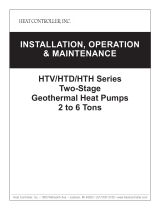
2
GENERAL
The manufacturer assumes no responsibility for equipment installed in violation of any code requirement.
These instructions give information relative to the installation of these heat pump units only. For other related equipment refer
to the proper instructions.
Material in this shipment has been inspected at the factory and released to the transportation agency in good condition. When
received, a visual inspection of all cartons should be made immediately. Any evidence of rough handling or apparent damage
should be noted on the delivery receipt and the material inspected in the presence of the carrier’s representative. If damage is
found, a claim should be filed against the carrier immediately.
If the equipment is not needed for immediate installation upon arrival at the job site then it should be left in its shipping carton
and stored in a clean, dry location. Units must be stored or moved in the normal upright position at all times. If stacking of units
is required, do not stack more than two units high.
Installation and servicing of this equipment can be hazardous due to the system pressure and electrical components. Only a
qualified licensed installer or service agency should install, repair or service the equipment. Untrained personnel can
perform basic functions of maintenance such as replacing filters.
Standard fluorocarbon refrigerant safety and handling practices should be followed when handling R-410A. Avoid skin and
eye contact with liquid refrigerant. Work in well ventilated areas since vapors are heavier than air and might concentrate
near the floor or in low areas. Additionally R-410A is non-flammable at normal room temperature, but can become
combustible if mixed with air at elevated temperature and/or pressure. Do not mix R-410A with air for leak testing or other
purposes. Instead use a mixture of R-410A and nitrogen for leak testing.
When servicing this equipment, because of the higher pressures, make sure the reversing valve, expansion device, filter
drier and other components are specifically designed for R-410A.
In keeping with its policy of continuous progress and product improvement, the manufacturer reserves the right to discontinue
or change without notice any or all specifications or designs without incurring obligations.
CAUTION:
R-410A systems operate at higher pressures than standard R-22 systems. Do not use R-22 service
equipment or components on R-410A equipment.
INTRODUCTION
Model nomenclature for the Water-to-Air Heat Pumps described in this installation instruction are as follows:
WSVC - Vertical, Single Package Water Source Heat Pump.
WSVX -Same, but with permanent magnet DC motor.
The WSV* Water-to-Air Heat Pumps are safety agency listed(see unit label) for zero clearance to combustible materials and are
designed for vertical applications with nominal refrigerant capacities of 18,000 through 59,000 BTUH. The WSV* series uses
scroll or reciprocating compressors with refrigerant R-410A to achieve high efficiency levels, quiet operation and reliable
performance. WSV* units are heat pump only units. No auxiliary electric heat or emergency heat is available with this unit.
Safety devices are built into each unit to provide the maximum system protection possible when properly installed and
maintained. Unit voltages offered are 230V, 265V and 460V with PSC or permanent magnet DC fan motors.
These units are designed to operate with the entering liquid temperature between 50 and 100 degrees F. With the extended
range option, the heat pump can operate with entering liquid temperatures between 30 and 100 degrees F.
CAUTION:
For all applications, 50 degree F minimum entering water temperature and sufficient water flow
is required to prevent freezing. Antifreeze solution is required for any application with entering water below
50 degree F.
Cooling Tower / Boiler and Geo Thermal applications should have sufficient antifreeze solution when required to protect against
extreme conditions and equipment failure. Frozen water coils are not covered under warranty.
CAUTION:
This unit must not be operated under any circumstances without an air filter in place or during
building construction due to excessive airborne dust and debris. Failure to follow this caution could result in
equipment damage and void unit warranty.
WARNING: R-410A can become combustible if mixed with air at elevated temperature and/or pressure.
Failure to follow this warning could result in property damage and personal injury or death.





















